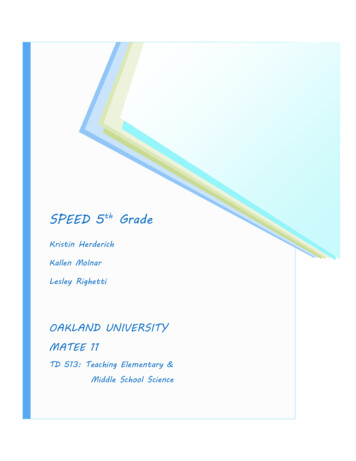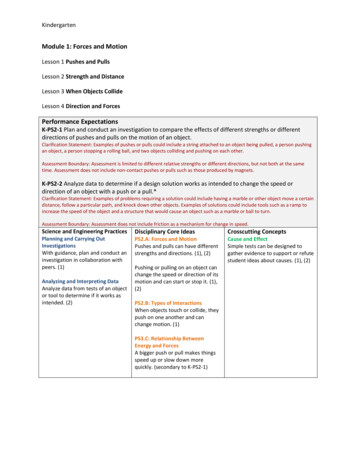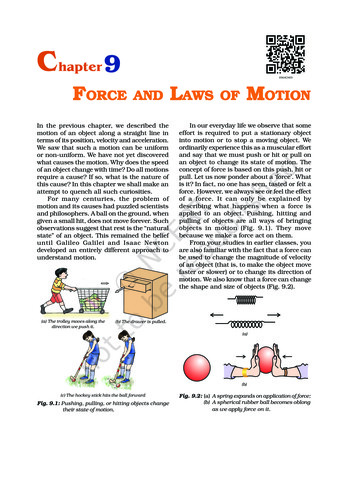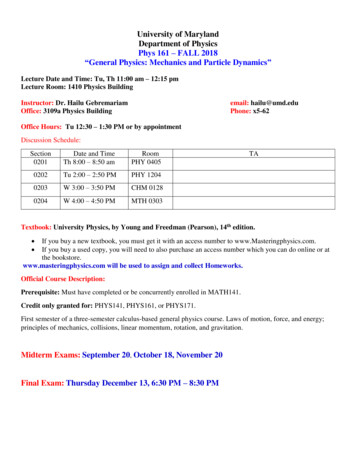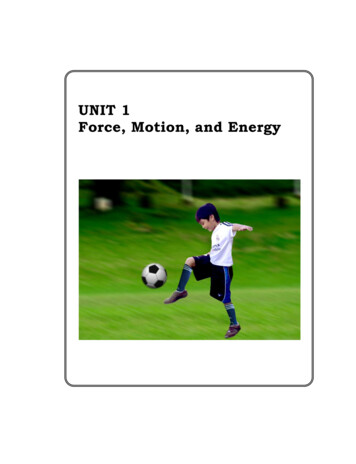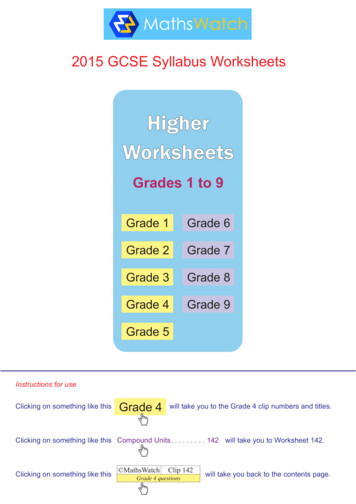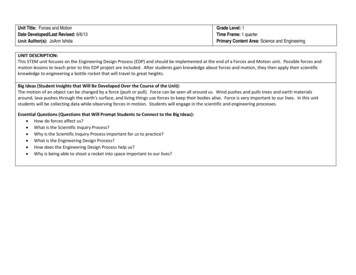
Transcription
Unit Title: Forces and MotionDate Developed/Last Revised: 6/6/13Unit Author(s): JoAnn IshidaGrade Level: 1Time Frame: 1 quarterPrimary Content Area: Science and EngineeringUNIT DESCRIPTION:This STEM unit focuses on the Engineering Design Process (EDP) and should be implemented at the end of a Forces and Motion unit. Possible forces andmotion lessons to teach prior to this EDP project are included. After students gain knowledge about forces and motion, they then apply their scientificknowledge to engineering a bottle rocket that will travel to great heights.Big Ideas (Student Insights that Will Be Developed Over the Course of the Unit):The motion of an object can be changed by a force (push or pull). Force can be seen all around us. Wind pushes and pulls trees and earth materialsaround, lava pushes through the earth’s surface, and living things use forces to keep their bodies alive. Force is very important to our lives. In this unitstudents will be collecting data while observing forces in motion. Students will engage in the scientific and engineering processes.Essential Questions (Questions that Will Prompt Students to Connect to the Big Ideas): How do forces affect us? What is the Scientific Inquiry Process? Why is the Scientific Inquiry Process important for us to practice? What is the Engineering Design Process? How does the Engineering Design Process help us? Why is being able to shoot a rocket into space important to our lives?
S/LEARNING GOALSCollect, record, and organize data using simple tools, equipment, and techniques safelyExplain the results of an investigation to an audience using simple data organizers (e.g. charts, graphs, pictures)Describe how the motion of an object can be changed by force (push or pull)TechnologyStandard 1: TECHNOLOGICAL DESIGN: Design, modify, and apply technology to effectively and efficiently solve problemsEngineeringStandard 1: TECHNOLOGICAL DESIGN: Design, modify, and apply technology to effectively and efficiently solve problemsSupporting Common Core MATH Standards:MathematicsCCSS.Math.Content.1.MD.A.2 Express the length of an object as a whole number of length units by laying multiple copies of a shorterobject (the length unit) end to end; understand that the length measurement of an object is the number of same-size length units thatspan it with no gaps or overlaps. Limit to context where the object being measured is spanned by a whole number of length units withno gaps or overlaps.CCSS.Math.Content.1.MD.C.4 Organize, represent, and interpret data with up to three categories; ask and answer questions about thetotal number of data points, how many in each category, and how many more or less are in one category than in another.Supporting Common Core LANGUAGE ARTS Standards:English LanguageArts and LiteracySTEMCompetenciesCCSS.ELA-Literacy.SL.1.1 Participate in collaborative conversations with diverse partners about grade 1 topics and texts with peers andadults in small and larger groups.CCSS.ELA-Literacy.W.1.8 With guidance and support from adults, recall information from experiences or gather information fromprovided sources to answer a question.Indicator 2.2: Collaborates with, helps and encourages others in group situationsIndicator 4.1: Recognizes and understands what quality performances and products are
Lesson Title/Description1Forces and Motion 2Lift Off Scientific InquiryProcess 3Build a Rocket EngineeringDesign Process LESSON SEQUENCELearning Goals(What Students Will Know and Be Able to Do)Students will know that motion is movementStudents will create motion with their bodies and observeobjects in motionStudents will know that a force is a push or a pullStudents will change the motion of objects using a forceStudents will be able to collect, record, and organize databased on observations using their 5 sensesStudents will be able to ask questions based on theirobservationsStudents will observe the forces of rocket propulsion throughthe Scientific Inquiry ProcessStudents will know that the Engineering Design Process is asystematic process used to design and redesign tools/productStudents will be able to design a rocket that will effectively andefficiently solve a problem using the Engineering DesignProcessAssessmentsFormative Teacherobservations/discussionsTime Frame2 45-minutesessionsSummative Summative Assessment onMotion Summative Assessment onForceFormative Teacherobservations/discussionsSummative Lift Off Scientific InquiryProcess Journal (useScientific Method Rubric forGr. 1)Formative KWL chartSummative Build a Rocket EngineeringDesign Process Journal Engineering Design ProcessReflections Engineering Design ProcessSummative Assessment(Use Engineering DesignProcess Rubric)Approx. 3-4 45minute sessionsApprox. 5-6 45minute sessions
Unit Title: Forces and MotionLesson Title: Forces and MotionDate Developed/Last Revised: 6/5/13Unit Author(s): JoAnn IshidaLesson: 1Grade Level: 1Primary Content Area: ScienceTime Frame: 45 minutesPLANNING (Steps 1, 2, & 3)1. Standards/Benchmarks and Process Skills Assessed in this Lesson: SC.1.7.1 Describe how the motion of an object can be changed by force (push or pull)2A. Criteria- What Students Should Know and Be Able to Do:Students will know Motion is movement A force is a push or a pullStudents will be able to Create motion with their bodies and observe objects in motion Change the motion of objects using a force2B. Assessment Tools/Evidence:Formative: Teacher Observations/DiscussionsSummative: Summative Assessment on Motion Summative Assessment on Force3. Learning Experiences (Lesson Plan)Procedure:What is motion? Teacher discusses examples of motion created by our bodies. (walking, running, jumping,hopping, skipping, swimming, etc.) Students demonstrate various motions with their bodies. Teacher demonstrates various motions created by objects. (rolling, sliding, lifting, etc.) Students play with various toys/models that move. Elicit the definition of “motion” from the students. (Motion is movement. Motion occurswhenever something changes place or moves.)Summative Assessment on Motion:What is motion? Draw an example of something in motion. Explain the motion that is occurring inyour picture.
What is force? Introduce the words “push” and “pull.” Have students use their body parts to push or pull objects/toys across the floor (cars, balls,tables, etc.) Elicit the definition of “force” from the students. (a force is a push or pull) Discuss which “force” is moving the object. (push or pull)Worksheet Example:ActionRoll ball across the floorWhat object is being moved?What force is being used?Push or pull?Open a desk drawerLift box off the floorSummative Assessment on Force:What is force? Draw an example of someone using force. Label the type of force being used onyour drawing. (Example: someone pulling a wagon)TEACHING & ASSESSMENT (Steps 4, 5, 6, &7)Completed by teacher after instruction has taken place4. Teaching and Collecting of Evidence of Student Learning:Teacher Notes:5. Analysis of Student Products/Performances - Formative:Teacher Notes:6. Evaluation of Student Products/Performances – Summative (Not necessary for every lesson):Teacher Notes:7. Teacher Reflection: Replanning, Reteaching, Next Steps:Teacher Notes:
STEM LessonUnit Title: Forces and MotionLesson Title: Lift Off Scientific Inquiry ProcessDate Developed/Last Revised: 6/6/13Unit Author(s): JoAnn Ishida, Lynn LumSeven-Step Implementation ModelLesson #: 2Grade Level: 1Primary Content Area: ScienceTime Frame: 3-4 45-minute sessionsPLANNING (Steps 1, 2, & 3)1. Standards/Benchmarks and Process Skills Assessed in this Lesson: SC.1.1.1 Collect, record, and organize data using simple tools, equipment, and techniquessafely. SC.1.1.2 Explain the results of an investigation to an audience using simple data organizers.(e.g. charts, graphs, pictures)Supporting Content Standard: SC.1.7.1 Describe how the motion of an object can be changed by force (push or pull)2A. Criteria- What Students Should Know and Be Able to Do:Students will know People use their five senses to make observations The motion of an object can be changed with a push or a pullStudents will be able to Use their five senses to make observations Observe the forces of rocket propulsion through the Scientific Inquiry Process2B. Assessment Tools/Evidence:Formative: Teacher Observations/DiscussionsSummative: Lift Off Scientific Inquiry Process Journal (Use Scientific Method Rubric for Gr. 1)3.Learning Experiences (Lesson Plan)Materials: Small, medium, and large plastic squeeze bottles (1 set per team is ideal. Each team wouldneed to test with the same set of squeeze bottles to control the variables. Suggestions:dishwashing liquid bottles with squeeze tops) Small paper cups that fit nicely on top of smallest bottle (1 per set of bottles)Handouts/Other Resources: Lift Off Scientific Inquiry Process Journal (1 per student) Scientific Method Rubric for Gr. 1
STEM LessonSeven-Step Implementation ModelMaterials: Small, medium, and large plastic squeeze bottles (1 set per team is ideal. Each team wouldneed to test with the same set of squeeze bottles to control the variables. Suggestions:dishwashing liquid bottles with squeeze tops) Small paper cups that fit nicely on top of smallest bottle (1 per set of bottles)Handouts/Other Resources: Lift Off Scientific Inquiry Process Journal (1 per student) Scientific Method Rubric for Gr. 1Procedure:Pre-assessment of the Scientific Inquiry ProcessAsk students: What are scientists? What do they do? How do scientists find answers to questions theyhave about the world? What is the Scientific Inquiry Process? Responses will be recorded on a class KWL chart.Scientific Inquiry ProcessDistribute “Lift Off Scientific Inquiry Process Journal” to each student. (The class will go througheach step of the process together with teacher.)Step 1: Make Observations Show NASA video of a rocket lifting 020#51803020 Students record observations in journal. Why is being able to shoot a rocket into space important to our lives?Step 2: Ask Questions Students ask questions based on their observations. Ex. What is making the rocket flyupwards? What force is making the rocket move up? How much force does it need tomake that heavy rocket move up?Step 3: Gather Information Optional: Read more on forces and motion if students need more exposure. Discusspossible answers to the questions above with students.Go back to Step 2: Ask Questions: Show students the paper cup “rocket” and the 3 squeeze bottle “launchers.” Have students ask more questions and record them on their journals. Ask students:Which of their questions are researchable? (Researchable means that students are able toset up an experiment that would answer their question with evidence/data.) Choose/Give the research question that students will be working on together as a class.(You may do other experiments with the class later.)
STEM LessonSeven-Step Implementation ModelResearch Question: Which launcher will make the rocket fly the highest?Step 4: Make a Hypothesis Students write a hypothesis.Example:If plastic bottles of different sizes are used to launch the rocket, then the rocket will go farthest withthe largest bottle because the large bottle is holds the most air.Step 5: Design the Study to Conduct the Experiment Read the step-by-step procedures. Make sure students understand what they are going to be doing.Step 6: Analyze the Results Collect and record data onto the data table in the Scientific Inquiry Process Journal. Analyze data by answering the questions located below the table.Step 7: Discussion and Conclusion Was the hypothesis supported or not supported? Why did this happen? (force not strong enough, not enough air in bottle, couldn’t squeezeit because plastic is too hard, etc.) Discuss discoveries and new knowledge. Discuss new questions.Complete KWL Chart. Discuss the components of the Scientific Inquiry Process.TEACHING & ASSESSMENT (Steps 4, 5, 6, &7)Completed by teacher after instruction has taken place4. Teaching and Collecting of Evidence of Student Learning:Teacher Notes:5. Analysis of Student Products/Performances - Formative:Teacher Notes:6. Evaluation of Student Products/Performances – Summative (Not necessary for every lesson):Teacher Notes:7. Teacher Reflection: Replanning, Reteaching, Next Steps:Teacher Notes:
Name:Date:Lift Off Scientific Inquiry Process JournalGrade 1: Forces and MotionSTEP 1: Make Observations:1.2.3.STEP 2: Ask Question(s): Mark the questions that are researchable.Research Question that our class will be working on together:STEP 3: Gather Information:
STEP 4: Make a Hypothesis:IfthenbecauseSTEP 5: Design the Study to Conduct the Experiment:Materials Needed: Plastic cups that fit on launchers Construction paper Markers Glue Tape ScissorsProcedure:Step 1: Place cup on top of small launcher.Step 2: Squeeze small launcher and measure how high the rocket flies upward.Step 3: Record your data on the table below.Step 4: Place rocket on top of medium launcher.Step 5: Squeeze medium launcher and measure how high the rocket flies upward.Step 6: Record your data on the table below.Step 7: Place rocket on top of large launcher.Step 8: Squeeze large launcher and measure how high the rocket flies upward.Step 9: Record your data on the table below.
STEP 6: Analyze the Results:Data Table 1: Height of Rocket Lift-OffsTrial 1Trial 2Trial 3SmalllauncherMediumlauncherLargelauncherWhat is the highest height for the small launcher?What is the highest height for the medium launcher?What is the highest height for the large launcher?Which launcher made your rocket fly the highest? Why?Step 7: Discussion and Conclusions:From my data, the hypothesis I made was (supported or not supported).I know this because the cupI think this happened because
New questions that I now have What did you learn about forces and motion?Big Idea: Why is being able to shoot a rocket into space important to our lives?Be prepared to share your conclusions with the class.
Scientific Method RubricSC.1.1.1: Collect,record, andorganize datausing simple tools,equipment, andtechniques safelySC.1.1.2: Explainthe results of aninvestigation toan audience usingsimple dataorganizers (e.g.,charts, graphs,pictures)AdvancedCollect, record,and organize dataaccurately, using avariety of simpletools, equipment,and techniquessafelyClearly explain, indetail, the resultsof an investigationto an audienceusing dataorganizersProficientCollect, record,and organize datausing simple tools,equipment, andtechniques safelyPartially ProficientCollect, record,and organize datausing simple tools,equipment, ortechniques safely,with assistanceNoviceCollect, record,and organize datasafely, with muchassistanceExplain significantresults of aninvestigation to anaudience usingsimple dataorganizersExplain, withassistance, theresults of aninvestigation to anaudienceExplain, with muchassistance, a partof an investigationto an audience
STEM LessonUnit Title: Forces and MotionLesson Title: Build a Rocket Engineering Design ProcessDate Developed/Last Revised: 6/6/13Unit Author(s): JoAnn Ishida, Lynn LumSeven-Step Implementation ModelLesson #: 3Grade Level: 1Primary Content Area: EngineeringTime Frame: 3-4 45-minute blocksPLANNING (Steps 1, 2, & 3)1. Standards/Benchmarks and Process Skills Assessed in this Lesson: CTE Standard 1: TECHNOLOGICAL DESIGN: Design, modify, and apply technology toeffectively and efficiently solve problems2A. Criteria- What Students Should Know and Be Able to Do:Students will know The six steps of the Engineering Design ProcessStudents will be able to Use the Engineering Design Process to design a rocket that will fly the highest2B. Assessment Tools/Evidence:Formative: Teacher Observations/ConversationsSummative: Build a Rocket Engineering Design Process Journal Engineering Design Process Summative Assessment Engineering Design Process Reflections Engineering Design Process Rubric3. Learning Experiences (Lesson Plan)Materials: Small cups (1 per team) Large plastic squeeze bottle as the launcher (e.g. dishwashing liquid squeeze bottle) Construction paper Glue Scissors Balance/digital scale to weigh the rocketHandouts/Other Resources: Build a Rocket Engineering Design Process Journal Engineering Design Process Rubric Engineering Design Process Reflections Engineering Design Process Summative Assessment
STEM LessonSeven-Step Implementation ModelProcedure:Before the lessonMake a launching pad site. The site should be located next to a wall with an “X” to mark the spotwhere the “launcher” (squeeze bottle) will be set. Place a measuring tape on the wall behind thepad site for students to measure the height of the lift-off. To measure the distance of the flightupwards, position the measuring tape so that it is above the cap of the launcher. Students can takethe measurement to the nearest inch or unit of measure.Pre-assessment of the Engineering Design ProcessAsk students: What is an engineer? What do they do? How do they design/improve models that help solvethe problems in our world? What is the Engineering Design Process? Responses will be recorded on a class KWL chart.We have just learned about forces and motion. In this lesson, students will be engineering a rocketthat can fly upward with the force of air from a squeeze bottle.Engineering Design Process Pass out a “Build a Rocket Engineering Design Process Journal” to each student.Note that the class will go through each step of the process together. Stop after each step todiscuss what the students did and the criteria needed. Teacher may refer to “EngineeringDesign Rubric” to help guide discussions. Do the number of steps you feel your students canhandle in the time allotted. It may take 1 day or many days to go through and understandthese steps. Don’t worry it’s the process that’s important. Just as they would in the real world, assign students to work with a partner.Note: Although students are part of a team, each student is responsible for completing eachpart of their own engineering design process journal. The team is there to help brainstorm,share ideas, and create one product, but each student must participate and contribute theirindividual ideas to help the group.Read performance task to students Performance TaskNASA needs your help! There’s something wrong with a satellite that is circling Earth. You are arocket engineer and your assignment is to design a rocket that will fly high into the sky to reachthat satellite. Your rocket will be tested with a launcher to see how high it goes upward. Goodluck on your mission! The people on Earth are counting on you!
STEM LessonSeven-Step Implementation ModelStep 1: Ask Read the criteria/constraints to the students. Show students the materials available to create their rockets. Consider keeping all ofthe materials on a “materials station” for easy access. Show students the launcher that will be used to test their rockets. Have students identify and write in their journals:o the problem of the performance tasko what they are creatingo Have students write further questions they may have about constructing this rocketo Have students share questions with the class for teacher to answerStop and go over the criteria for the “Ask” section of the process. Teacher monitors studentlearning by recording observations of the questions students are asking. (See Engineering DesignProcess Rubric)Step 2: Imagine Instruct students to independently brainstorm ideas for building a rocket and draw or writeout ideas in their journal. After each student has the chance to express their own ideas, encourage them to discusstheir ideas with the rest of the engineering team. Students should defend their reasons forusing specific ideas from their prototype. (Ex. Lightweight so rocket can shoot higher intothe air) Tell students that each engineering team may then decide on ONE person’s design to use orcreate ONE new hybrid idea incorporating all the differing ideas.Stop and go over the criteria for the “Imagine” section of the process. Teacher monitors studentlearning by recording observations of the ideas students are generating. (See Engineering DesignProcess Rubric)Step 3: Plan Designate one person to sketch a diagram of the team’s “rocket” prototype onto a piece ofpaper. This sketch should include labels for each of the parts and possible measurements.The sketcher must be sure to incorporate all the agreed upon ideas into the design. Studentsthen list all possible materials that will be needed to create the prototype. Inform students that when all team members are satisfied with the prototype design, eachmember should copy this diagram of the rocket onto their own journals. Instruct team members to check with each other to see if all drawings and labels arecompleted and everyone has the same plan to follow.Stop and go over the criteria for the “Plan” section of the process. Teacher monitors studentlearning by recording observations of the plan students are creating. (See Engineering DesignProcess Rubric)
STEM LessonSeven-Step Implementation ModelStep 4: Create Instruct students to follow their team plan as closely as possible when building theirprototype. If they are modifying their original prototype to make their prototype work, guidestudents to be sure each person writes down and adds that information to their journaldiagram plans as well. Ask teams to share their prototype rocket to the large group, stating what modifications weremade to the plan and why.Stop and go over the criteria for the “Create” section of the process. Teacher monitors studentlearning by recording observations to see if students are following/modifying their plans. (SeeEngineering Design Process Rubric)Step 5: Experiment Test it out! Measure the weight of your rocket. Bring your rocket to the launching pad. Place rocket on bottle and squeeze! Measure the height that the rocket flew. Log data onto student journals. Circle the trial with the highest height.Have teams share out their data and the reasons for their results to the class. Teacher may chartthe heights of each rocket for all students to see and compare. (Students will be learning fromeach other and using other people’s ideas, as well as their own, as they are improving upon theirprototype)Stop and go over the criteria for the “Experiment” section of the process. Teacher monitorsstudent learning by recording observations of how students collected and analyzed their data.(See Engineering Design Process Rubric)Step 6: Improve Have each team review the results of their data. Repeat the EDP to optimize the product. Students would continue to record the following intheir journal o Ask: What worked? What didn’t work? Why?Fill in “Things to consider” part of the journal. This helps the students to think aboutcertain aspects of their rocket that they may not have thought of that they may wantto change in the redesign. Students write their ideas on how they are going to modifytheir rockets.o Imagine: Which variables will they change to make their rocket fly higher? What’sthe rationale for the changes?
STEM LessonSeven-Step Implementation Modelo Plan: Draw the diagram of the team’s 2nd prototype. Label the parts withmeasurements.o Create: Build your second prototype following your team’s design. Keep to the plan.o Experiment:o Measure the weight of your rocket.o Bring your rocket to the launching pad.o Place rocket on bottle and squeeze!o Measure the height that the rocket flew.o Log data onto student journals. Circle the trial with the highest height.o Write 3 facts comparing the data tables for prototypes 1 and 2.o Analyze data and explain the results that you find.Note: You may go through this EDP cycle many times to get an optimized product. It all dependson the amount of time you have available.Summary and Conclusions: Have each team share their rocket design, how they modified their rocket, a rationale fortheir changes, and the results. They may also share what they learned about the forces ofpush and pull and motion. Complete the KWL chart. Discuss what students have learned about the Engineering DesignProcess. Complete EDP Journal Have students complete EDP Reflections Have students complete EDP Summative Assessment (Use EDP Rubric)TEACHING & ASSESSMENT (Steps 4, 5, 6, &7)Completed by teacher after instruction has taken place4. Teaching and Collecting of Evidence of Student Learning:Teacher Notes:5. Analysis of Student Products/Performances - Formative:Teacher Notes:6. Evaluation of Student Products/Performances – Summative (Not necessary for every lesson):Teacher Notes:7. Teacher Reflection: Replanning, Reteaching, Next Steps:Teacher Notes:
Name:Date:Build a Rocket Engineering Design Process JournalGrade 1: Forces and MotionPerformance Task: NASA needs your help! There’s something wrong with a satellite that iscircling Earth. You are a rocket engineer and your assignment is to design a rocket that will flyhigh into the sky to reach that satellite. Your rocket will be tested with a launcher to see howhigh it goes upward. Good luck on your mission! The people on Earth are counting on you!Criteria/Constraints: The rocket will be made with materials provided. The launcher is a large plastic bottle.What is the problem?What is your task?STEP 1: ASK - Ask questions that pertain to completing the performance task.1.2.STEP 2: IMAGINE -Use your background knowledge of forces and gravity to design a rocket. These are some ideasyou should consider when creating your rocket: weight, size of cup, shapeDraw your possible designs and label the parts. Be ready to share and discuss your design and explain the rationale foryour design choices. Your design team will be choosing one to develop.
STEP 3: PLAN -Draw the diagram of your team’s prototype. Label each part. Also state the type of material usedfor each part and the possible measurements.Side view:STEP 4: CREATE -Build your prototype following your team’s design. Keep to the plan.What modifications did you need to make in order to be sure that your design would hold together and work?STEP 5: EXPERIMENT -Trial 1Trial 2Trial 3Data Table 1Weight of RocketHeight of Flight (Inches)
STEP 6: IMPROVE - Go through the process again to redesign and optimize your product.ASK: Looking at your data, answer the following questions: What worked? Why?What didn’t work? Why?Things to Consider Did itwork?Shape of bodyYes(aerodynamics)A littleNoWeight of rocketSize of rocketOtherWhy or why not?YesA littleNoYesA littleNoYesA littleNoIMAGINE: What will you change to help the rocket fly higher?Why do think that idea will work?
PLAN: Draw out a diagram of your team’s 2nd prototype.Remember to label your parts, state the type of materialused for the part, and possible measurements.Side View:CREATE: Build your 2nd prototype following your team’s design.Keep to the plan.EXPERIMENT:Trial 1Data Table 2Weight of RocketHeight of Flight (Inches)Trial 2Trial 3Write at least three facts comparing data tables 1 and 2.1.2.3.
Data Analysis:Which prototype was more effective?Prototype 1Prototype 2(circle one)Why was it more effective?If you had more time and materials, what would you do to make your rocket fly even higher?Explain your thinking.
Engineering Design Process RubricAdvanced OVEDDProficient (M)Clarifies the problem clearlyForms the conditions andlimitations on their ownObtains information fromprior knowledge and othersources with citation by selfDDBrainstorms a variety ofinnovative ideasInnovative ideas are relevant tothe problemDDChooses the best possible ideathat is testableDraws a useable and accurateprototype design with morethan 2 views to scaleLists all materials needed thatare affordable, obtainable, andsafeAble to follow their designplan accuratelyAble to improve originaldesign to optimizeperformanceDDDDPartially Proficient (DP)Clarifies the problemStates all the conditions andlimitationsObtains information fromprior knowledge by selfDBrainstorms a complete ideaIdea is relevant to the problemDDChooses one idea that istestableDraws a useable prototypedesign with multiple views toscaleLists all materials needed.DDDDDDDCollects and records detaileddata accurately and completelyAnalyzes data by comparingpatterns and relationshipsaccurately with logicDReviews data to make logicaldecisions to optimize productRepeats process until anoptimized product is reachedwith greatly improved data.DDDAble to follow their designplan, with some inaccuraciesAble to add to the originaldesign to make the designworkDCollects and records dataaccurately and completelyAnalyzes data by showingpatterns or relationshipsaccuratelyDReviews data to make decisionsto redesign productRepeats process to optimize aproduct. Data may/may notshow improvementDDDDNovice (WB)Needs more clarification of theproblemStates most conditions andlimitationsObtains information fromprior knowledge (drawn out byteacher)Brainstorms an incomplete ideaIdea is somewhat relevant tothe problemDDChooses an idea that may betestableDraws a somewhat useableprototype design with multipleviews with inaccurate orincomplete measurementsMost materials needed arelistedAble to follow most of theirdesign plan with multipleinaccuraciesAble to add to the originaldesign, but design may still notworkCollects and records data.Some data may be incompleteor inaccurate.States obvious patterns orrelationshipsDReviews data to make decisionsto redesign product withassistanceRepeats process to improveproduct with some assistance.DDDDDDDDDDDProblem is unclearStates few (or no) conditionsand limitationsInformation given by teacherUnable to brain
Unit Title: Forces and Motion Date Developed/Last Revised: 6/6/13 . Unit Author(s): JoAnn Ishida . Grade Level: 1 . Time Frame: 1 quarter . Primary Content Area: Science and Engineering . UNIT DESCRIPTION: This STEM unit focuses on the Engineering Design Process (EDP) and should be implemented at the end of a Forces and Motion unit. Possible .


